Stalin's seventh strike: Yassko-Chisinau Cannes
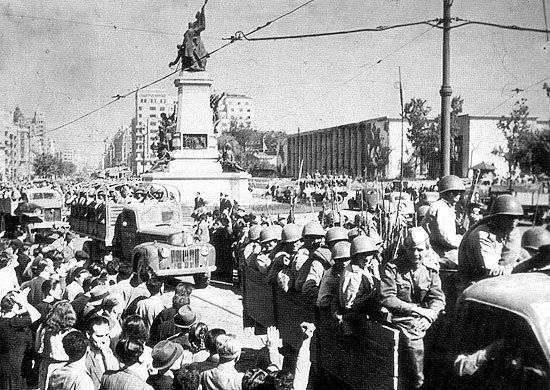
70 years ago, the Soviet armies liberated the Moldavian SSR, removed Romania from the war, and made their way to the Balkans. The Yassy-Chisinau operation (20 — 29 in August 1944) was the seventh Stalinist strike. “Yassko-Chisinau Cannes” is considered one of the most successful Soviet operations during the Great Patriotic War. The troops of the 2 of the Ukrainian Front, under the command of General Rodion Malinovsky and the 3 of the Ukrainian Front, General Fyodor Tolbukhin, were able to destroy the main forces of the Army Group "Southern Ukraine".
Prehistory The political situation in the Balkans
The situation in the Balkans during the war was complicated. Yugoslavia and Greece were occupied by German troops, Albania - by the Italians. Romania and Bulgaria preferred to become allies of the Third Reich. At the same time, they had a different situation. The Romanian dictator Ion Antonescu and his supporters were active allies of Germany and dreamed with the help of the Germans to realize the construction plan of the “Great Romania”. Romanian nationalists, unable to return Southern Dobrudzhu and Northern Transylvania (they had to be ceded to Bulgaria and Hungary), wanted to compensate Romania’s losses as much as possible at the expense of Soviet (Russian) territories.
In accordance with the German-Romanian Treaty, signed in 30 Bender on August 1941, Transnistria was formed. The Romanians gained control of the territory between the Southern Bug and the Dniester. It included parts of the Vinnitsa, Odessa, and Nikolaev regions of Ukraine and left-bank Moldova. In the future, the appetites of the Romanian radicals were even more played out: they began to dream of joining the “Greater Romania” territories up to the Dnieper and even further. Some politicians agreed on the “Romanian empire to the gates of Asia,” that is, to the Urals, demanding the creation of a “living space” for the Romanian nation.
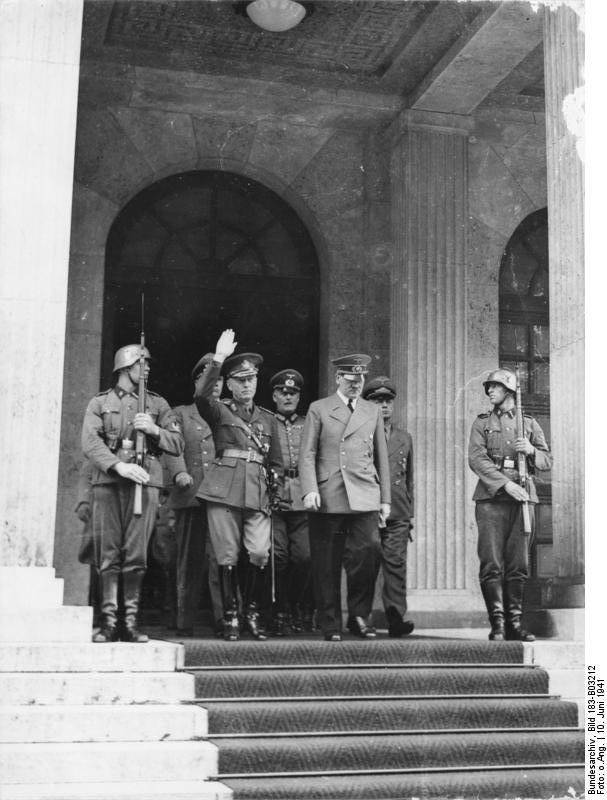
10 June 1941 of the year. Antonescu and Hitler leave the Führerbau (Munich)
However, these dreams broke about the power of the Red Army. The Romanian army suffered terrible losses during the Battle of Stalingrad, the Odessa and Crimean operations 1944 of the year (The third Stalinist blow. The liberation of Odessa; The third Stalinist blow. Battle of the Crimea). Romania, as a result of the Soviet offensive, lost control of Northern Bessarabia and Odessa. At the end of March 1944, the fighting was moved to the territory of Romania. In summer, a lull was temporarily established at the front. Moscow offered Romania a truce on its own terms, but the Romanian government categorically refused peace with the Soviet Union, continuing the war on the side of the German Empire.
Antonescu was nervous, the situation was critical. He hinted to Hitler that the best way out would be to make peace with England and the United States, to concentrate all forces against the Soviet Union. However, the Führer reassured him. Hitler promised that the German troops would defend Romania, like Germany itself. This is not surprising, given that the main oil reserves were located in Romania. The defeat of the German-Romanian troops in the Iasi-Chisinau operation led to the fall of the Antonescu regime. The Romanian King Mihai I, united with the anti-fascist opposition, ordered the arrest of Antonescu and the pro-German generals, led Romania out of Hitler’s coalition and declared war on the Third Reich. As a result, the Romanian army became an ally of the Red Army and fought on the side of the USSR in Hungary and Austria.
Bulgaria was an ally of Germany, but did not go to war with the Soviet Union. Bulgarian Prime Minister and President of the Bulgarian Academy of Sciences Bogdan Filov was a big fan of Hitler. In 1941, he joined Bulgaria to the Berlin Pact and the Anti-Comintern Pact. With the support of Berlin, Sofia returned South Dobroja, lost during the Second Balkan War in 1913. In 1941, Bulgaria agreed to give its territory to the Wehrmacht for the war against Greece and Yugoslavia. With the consent of Berlin and Rome, Bulgarian troops occupied territories in Macedonia and northern Greece. As a result, "Great Bulgaria" was formed.
After the attack on the USSR, Berlin repeatedly demanded that Sofia send Bulgarian troops to the Eastern Front. But Tsar Boris III took into account the traditional sympathies of the Bulgarian people to the Russians. Therefore, Bulgaria declared war on Britain and the United States, but the USSR did not declare war. True, this neutrality was not complete. The Third Reich had the opportunity to develop deposits and mining in Bulgaria. Sofia presented its territory for the basing of the German troops, contained them, made it possible to use the entire infrastructure - airfields, railways, ports, etc.
After a radical change in the war, the situation escalated. After Stalingrad and the Kursk Bulge, Adolf Hitler was looking for sources of replenishment of manpower, he wanted to use the Bulgarian army on the Eastern Front. And Tsar Boris realized that the star of the Third Reich was rolling, and tried to break off the alliance with Germany. He began to express ideas that Sophia could mediate between Berlin and the allies in peace negotiations. In August, 1943, the king flew to the Führer in East Prussia. The essence of their conversation is unknown. 28 August 1943, a few days after his return to Sofia, Tsar Boris III died suddenly. According to the official version - from a heart attack. About the true reason historians argue to this day. Some believe that the Nazis poisoned the Bulgarian tsar, trying to prevent separate negotiations between Bulgaria and the allies. Others say that Boris was worried after a difficult conversation with the Fuhrer. The heart, weakened by alcohol, could not stand it. Still others hold the opinion that he was poisoned by his own confidants, supporters of the alliance with Germany. They feared a change of policy, loss of power and arrests.
Throne occupied 6-year-old king Simeon. The Regent Council, consisting of Brother Boris Prince Kirill, Prime Minister Filov, and General Nikola Mihov, ruled on behalf of him. They were all supporters of an alliance with Germany. The Regency Council and the new Prime Minister Dobri Bozhilov pursued a loyal Germany policy. But a full-fledged alliance with Germany did not work. The Bulgarian army was not thrown into battle with the Soviet army. The temporary workers were afraid that the army would go over to the side of the Fatherland Front (coalition of anti-fascist forces) and turn weapon against them themselves. In the meantime, opposition forces have seriously increased. Rumors about the killing of the king, dissatisfaction with the policies of the regents and the defeat of Germany on the Eastern Front sharply increased the number of dissatisfied.
18 May 1944, the Soviet government demanded that Sofia stop providing assistance to the German army. The internal crisis and deterioration on the Eastern Front forced the Bozhilov government to resign. The new government was headed by the representative of the agrarians Ivan Bagryanov. The new government at the same time tried not to run into war with Germany, pacify the USSR and the internal opposition, and begin negotiations with the United States and Great Britain.
12 August 1944 Moscow again demanded Sofia to stop rendering assistance to Germany. On August 26, when the defeat of the German forces in the Yassy-Chisinau operation became apparent, Bagryanov announced the neutrality of Bulgaria and demanded the withdrawal of German troops from the country. At the same time, the Bulgarian government did not take any measures to neutralize the German garrisons in Bulgaria and did not interfere with the Wehrmacht movement. Therefore, the German forces retreating from Romania calmly passed through Bulgarian territory into Yugoslavia.
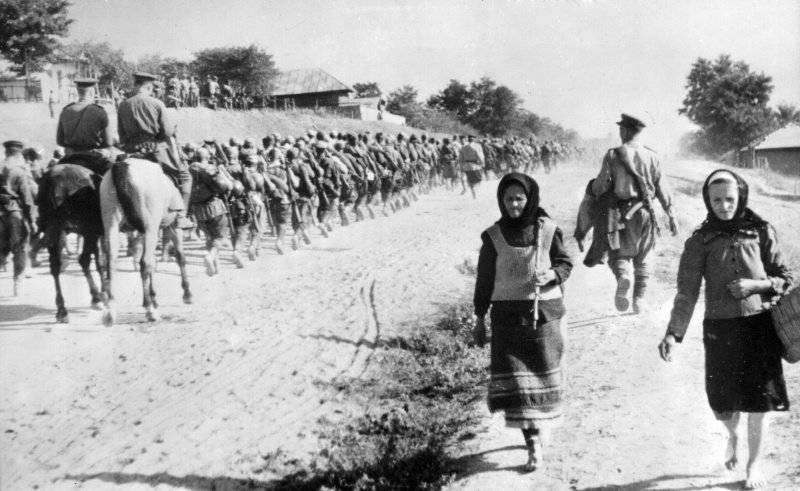
Part of the 49-th Guards Rifle Division of the 5-th Shock Army of the 3-th Ukrainian Front on the march during the Yassy-Kishinev operation
Situation at the front
Completion of the Lviv-Sandomir operation (Stalin's sixth strike. Lviv-Sandomierz operation) almost coincided with the start of a new offensive by the Soviet armies in the south-western strategic direction. 31 July 1944 at the Headquarters of the Supreme Command under the leadership of Joseph Stalin held a military meeting on the preparation of the new offensive of the 2 and 3 of the Ukrainian fronts. The meeting was attended by front commanders Rodion Yakovlevich Malinovsky and Fyodor Ivanovich Tolbukhin. Also present was the representative of the Stavka in the southwestern direction, Semyon Konstantinovich Timoshenko.
According to the memoirs of S. M. Shtemenko, the “highlight” of the plan of the Iasi-Chisinau operation was the idea of powerful flanking strikes to encircle and destroy the powerful Chisinau enemy group. The fact was that the German command was expecting the main attack of the enemy in the Chisinau direction and concentrated on it the main forces of the Wehrmacht and the most combat-ready German divisions. Moreover, the troops were located compactly in the tactical zone. That is, the German command hoped to repay the Soviet strongest first strike at shallow depths. Apparently, the Germans planned that if things go wrong, they will be able to retreat to positions that they prepared in the depths of the defense. At the same time, the main German operational reserves were located to counter the attacks of the Soviet armies in the Chisinau direction. True, they were small and consisted of two infantry and one tank divisions. On the flanks of the Chisinau group, weaker Romanian armies defended. Romanians were far inferior to the Germans in combat qualities. Romanian troops were much worse armed, trained and equipped. According to Soviet intelligence, the morale of Romanian soldiers was low. Many soldiers and even entire units were tired of defeats, high losses and were opposed to the Germans.
Therefore, at the meeting, the Stavka came to the conclusion that the best option would be flank attacks with the aim of encircling and destroying in a short time the main forces of the Army Group “Southern Ukraine” in the Chisinau region. The first task was to achieve a surprise start of the offensive and a high rate of advance of the Red Army. It was necessary to take the crossing over the Prut River before the enemy could use them. For this, it was necessary to advance at a speed of at least 25 km into knocks. In order to ensure a quick breakthrough of the defense of the German-Romanian troops, it was decided to weaken all the minor sectors of the 2 and 3 of the Ukrainian fronts and thereby create a huge advantage in the breakthrough sectors. In addition, the breakthrough sites themselves were greatly reduced (on the 2-m Ukrainian front - 16 km, on the 3-m Ukrainian - 18 km), sharply increasing the density of artillery fire. High density artillery guaranteed a quick breakthrough of the enemy’s defenses, and the development of success in depth to the crossings on the Prut River. Tank fronts, mechanized and cavalry formations were proposed to be used after breaking through the enemy defenses to develop the offensive in the operational depth and quickly capture the crossings to the r. Rod, for forcing the river. Siret. Stalin noted the great political significance of this operation. It was supposed to influence the policy of Romania and lead to its withdrawal from the Hitler coalition.
The situation was facilitated by the fact that the methodology of the Soviet Stavka - “Stalinist strikes”, which were consistently applied first in one direction and then in the other, fully justified itself. The Belarusian (Operation Bagration) and Lviv-Sandomierz operations were in full swing (they ended on August 29), the Soviet offensive in these areas was stalled. The German command hastily patched the "holes", reestablished the collapsed front line, hastily transferring troops from Germany, Western Europe, and the "quiet sections" of the Eastern Front. Including from the end of June to 13 of August 12 divisions were removed from Moldova. Meanwhile, the Soviet armies rested, supplemented with manpower and equipment. 2-th Ukrainian front of Marshal Malinovsky and 3-th Ukrainian Marshal Tolbukhin prepared for a new offensive.
It cannot be said that the preparation of the Soviet armies for a new offensive remained for the Germans a complete mystery. German and Romanian intelligence discovered some rearrangements of the Soviet troops, the supply of ammunition and other menacing signs of approaching the enemy’s offensive. However, the Soviet command was still able to deceive the Germans. To this end, misinformation about the upcoming local operation was launched, which will be aimed at leveling the front and taking Chisinau. On Chisinau direction in the radio began to flash the call sign of the "fresh parts". Demonstratively conducted intelligence, including in combat. The German command believed. On the Kishinev direction pulled the available reserves.
In addition, the fear of the command of the army group "Southern Ukraine" caused the behavior of the Romanian elite. The entourage of King Mihai I of Romania was actively looking for ways of drawing closer to the powers of the anti-Hitler coalition. By August, a conspiracy against Antonescu led by the king was ripe. In the event of the start of a major Soviet offensive, the conspirators planned to either convince the dictator to conclude an armistice with the Soviet Union or arrest him. Already 3 August, the commander of Army Group “Southern Ukraine” Johannes Frisner, having received information that the dictator Antonescu could at any moment overthrow sent a letter to Hitler. He offered to subjugate all the troops and military institutions in Romania. He also said that if fermentation is noticed at the front of the Romanian troops, it is necessary to immediately start withdrawing army groups to the line on the Prut River, and further to the Galati, Focsani line, the spurs of the Eastern Carpathians.
However, Hitler and Keitel did not give such permission. They did not give to Frisner and the rights of the commander in chief. True, Ribbentrop proposed, in order to calm the Romanian leadership, to introduce a tank division into Bucharest. But there were no free tank divisions on the Eastern Front. Then they proposed to send the 4 SS police division from Yugoslavia to the Romanian capital, but Jodl opposed this idea. He believed that the SS troops were necessary to fight the Serbian partisans and it was not worthwhile to weaken the German troops in this area. In general, Frisner’s idea of withdrawing troops to the Prut River could ease the position of Army Group South Ukraine, although it would not prevent Romania’s withdrawal from Hitler’s coalition.
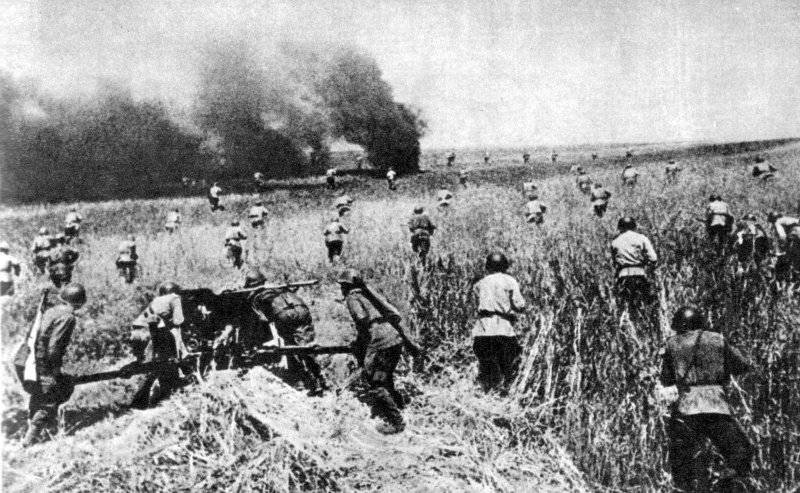
The troops of the 2 of the Ukrainian Front are conducting an offensive near Iasi.
The idea of the Soviet command. Soviet forces
The Soviet command decided to deliver the main attacks on the flanks of the German grouping, on two far sections of the front. The operation involved forces of the 2nd and 3rd Ukrainian fronts, the Black Sea Fleet under the command of Admiral F.S. Oktyabrsky and the Danube Military flotilla Rear Admiral S.G. Gorshkov. The 2nd Ukrainian Front was to strike northwest of Yass, the 3rd Ukrainian Front - south of Bender (Suvorov Mountain).
The troops of the fronts were supposed to break through the enemy’s defenses and develop an offensive along the lines converging towards the Husi – Vaslui – Felciu region in order to take the encirclement and then destroy the main forces of the enemy’s Chisinau group. Then the Soviet troops had to quickly develop an offensive deep into Romanian territory in the general direction of Fokshany, Ishmael, not to allow the enemy to leave behind the Prut and Danube, and provide the right wing of the strike group from the Carpathians. The Black Sea Fleet was supposed to support the coastal flank of the 3rd Ukrainian Front, disrupt maritime communications, defeat the enemy naval forces and with the help of aviation attack naval bases in Sulina and Constanta.
The shock grouping of the 2-th Ukrainian Front included 3 combined-arms (7-I Guards, 27-I and 52-I armies) and one tank army (6-I tank army). In addition, the front had a number of mobile units - the 18-th separate tank corps and the horse-mechanized group (it included the 5-th Guards Cavalry Corps and the 23-th tank corps). Under the leadership of Malinowski also were 40-I, 4-I Guards Army and 5-I Air Army.
The shock grouping of the 3-th Ukrainian Front consisted of three combined-arms armies - the 5-th shock, the 57-th and 37-th army. In addition, the front included the 46 Army, 7 Mechanized 4 Guards Mechanized Corps. From the air, the troops of the front were supported by the 17-I Air Army.
In total, Soviet troops numbered more than 920 thousand soldiers and commanders, 1,4 thousand tanks and self-propelled guns, 16,7 thousand guns and mortars, more than 1,7 thousand airplanes (according to other data, more than 1,2 million people, more than 1,8 thousand tanks and self-propelled guns, 16 thous. Guns and mortars, 2,2 thous. Aircraft). Aviation of the Black Sea Fleet numbered about 700 aircraft. The Black Sea Fleet (including the Danube Flotilla) had a 1 battleship, 4 cruisers, 6 destroyers, 30 submarines and 440 other ships and ships.
Germany
Before the Red Army, the front was defended by Army Group South Ukraine. It included two army groups: in the Jaskan direction, the Wöhler group (it included the 8-I German and 4-I Romanian armies and the 17-I German army corps) and in Chisinau, the Dumitrescu (6-I German and 3-I Romanian army). From the air, Army Group South Ukraine supported the 4 air fleet. All in all, Army Group had 25 German (including 3 tank and 1 motorized), 22 Romanian divisions and 5 Romanian infantry brigades. German-Romanian troops numbered 643 thousand soldiers and officers in combat units (about 900 thousand people in total), more than 400 tanks and self-propelled guns, 7,6 thousand guns and mortars, more than 800 combat aircraft.
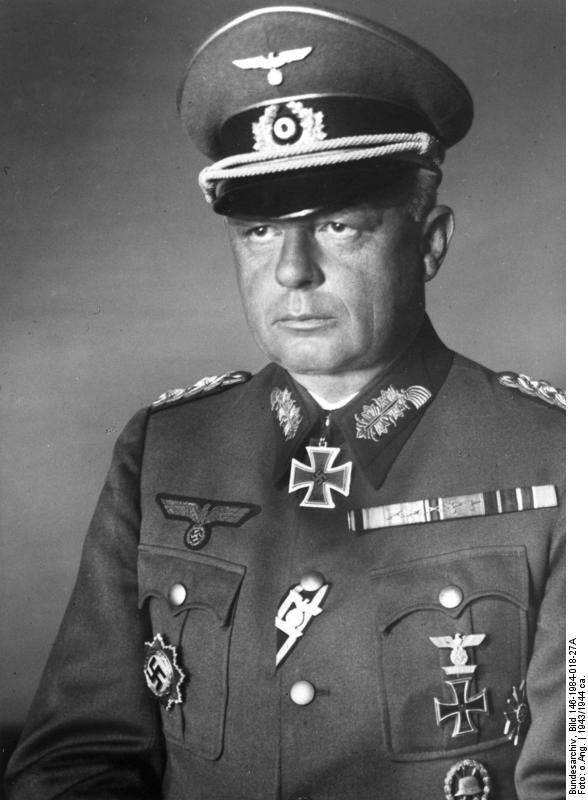
Army Commander Southern Ukraine, Johannes Frisner
To be continued ...
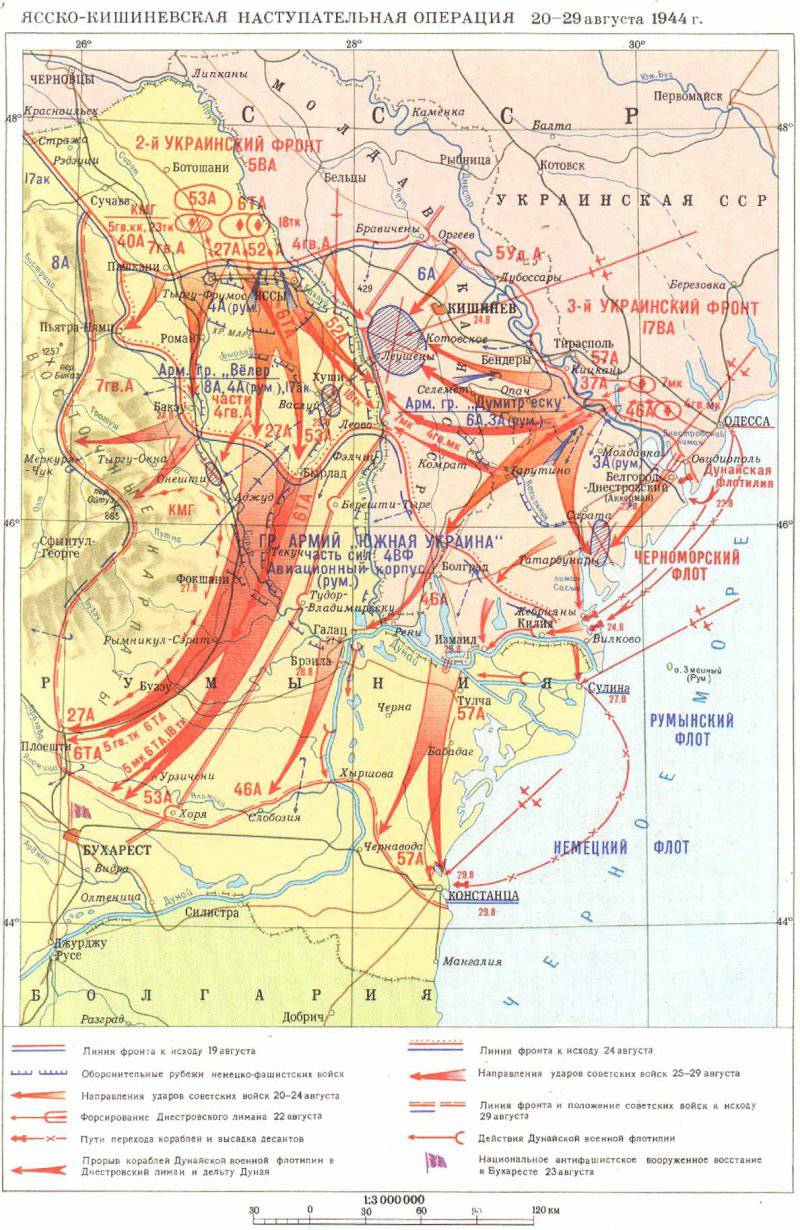
Information